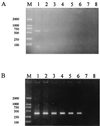Identification of Ehrlichia chaffeensis by nested PCR in ticks from Southern China
- PMID: 10878087
- PMCID: PMC87030
- DOI: 10.1128/JCM.38.7.2778-2780.2000
Identification of Ehrlichia chaffeensis by nested PCR in ticks from Southern China
Abstract
A total of 717 ticks collected from southern China were examined by nested PCR for the presence of Ehrlichia chaffeensis. Sixteen (55. 2%) of 29 adult Amblyomma testudinarium ticks and 28 (11.7%) of 240 adult and at least 4.2% of 215 nymphal (pooled specimens) Haemaphysalis yeni ticks tested positive. Four other species of ticks were negative. Selected positive amplicons were confirmed by DNA sequencing.
Figures


References
-
- Anderson B E, Sims K G, Olson J G, Childs J E, Piesman J F, Happ C M, Maupin G O, Johnson B J B. Amblyomma americanum: a potential vector of human ehrlichiosis. Am J Trop Med Hyg. 1993;49:239–244. - PubMed
-
- Goodman J L, Nelson C, Vitale B, Madigan J E, Dumler J S, Kurtti T J, Munderloh U G. Direct cultivation of the causative agent of human granulocytic ehrlichiosis. N Engl J Med. 1996;334:209–215. - PubMed
Publication types
MeSH terms
Substances
Associated data
- Actions
LinkOut - more resources
Full Text Sources
Molecular Biology Databases

